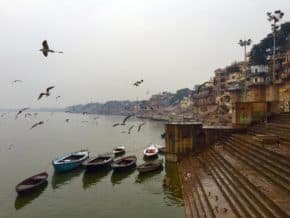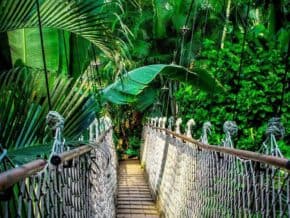If you've ever dreamed of climbing Mount Everest—or if you're simply looking for an adventure of a lifetime—then the Everest Base Camp Trek is perfect for you. You can't get any closer to Mount Everest without actually climbing it!
Located in Nepal, the journey takes you through some of the most beautiful and breathtaking scenery on Earth, providing you with memories that will stay with you forever.
This world-famous trek is one of those once-in-a-lifetime experiences that are well worth the price tag. If Mount Everest base camp has been on your wish list and if you're wondering how much it costs, read on. We'll break it all down for you in USD.
How much does it cost to reach Everest Base Camp?
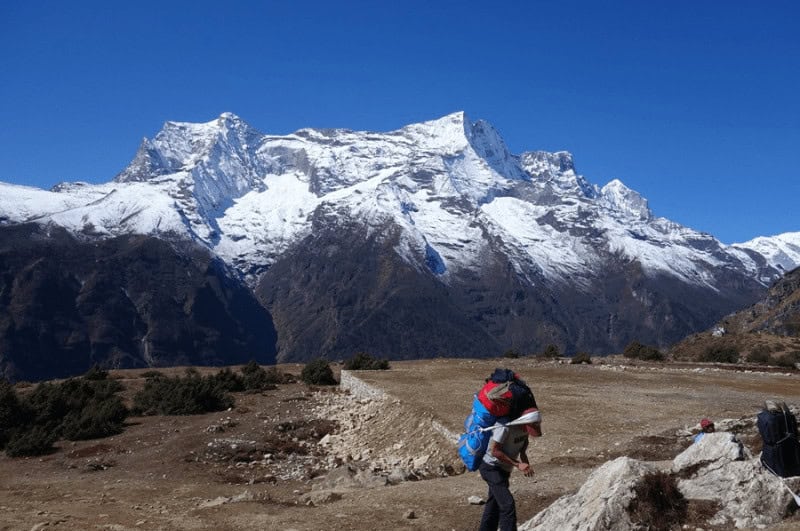
The cost of the Everest Base Camp trek depends on several factors, including:
- the season
- the route
- the number of days spent on the trail
- level of accommodation
- cost of food and water
- plane fare to/from Nepal
- cost of guides and porters
- and whether you choose a group tour or go on your own.
Other variables include your Nepal visa duration, flights to/from Lukla, and any gear you may need to rent or purchase.
You'll typically need 12-14 days of full-on trekking to complete the 80-mile (130 km) roundtrip from Lukla (9,200 feet) to Mount Everest Base Camp (17,500 feet). However, if you're not in tip-top shape, it's best to opt for more days. Longer treks give you more time to adjust to the extreme change in altitude.
The cheapest way is to do it on your own. A 12-day trek will cost around $360 – $500 (around $30 to $40 per day), depending on your preferred level of comfort. But unless you are an experienced hiker who is used to being at high altitudes and long distances, it might not be a good idea to go alone.
Guided treks to Everest Base Camp will cost between $1200 and $4500 ($125 to $335 per day), and local businesses are typically less expensive than international tour operators. For example, a famous expedition company, Nepal Hiking Team, offers routes with prices starting under $1300.00, while Viator's offers a 15-day trek for a few hundred more.
If a multi-day, long-distance, high-altitude trek isn't for you, you can do an Everest helicopter tour in less than one day! This experience costs $1000 per person (on a sharing basis) and $4200 for a chartered flight (minimum 5 passengers).
ⓘ TIP: If you're looking for some Everest base camp trek quotes, scroll to the end of this article, where you can find a few good options.
Costs before starting the EBC (Everest Base Camp) trek
Not all of your expenses will be included in the price of your trek. There are some costs you’ll need to incur even before starting your journey, so you'll need to factor these in as well.
International flights to Nepal
You’ll need to take a flight from your home country to Nepal. I recommend booking the flight in advance, to ensure you get the seat and flight you want. The ticket price is subject to change at any time, and will only increase as the date of departure approaches.
The price for your ticket depends on the season, airline, and where you’re flying from, as well as the day of the week you're flying. A direct flight from San Francisco to Kathmandu will cost anywhere between $800 – $1400.
Tourist visa for Nepal
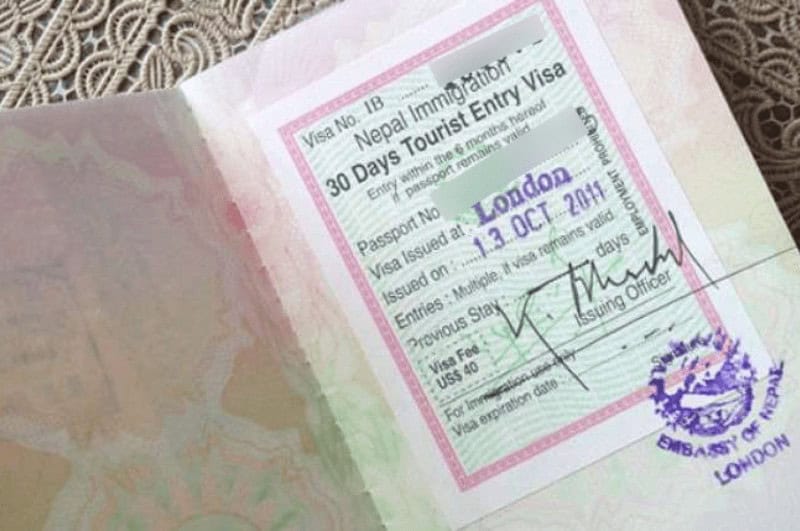
You can get a visa on arrival in Nepal. A visa is mandatory for everyone who wants to enter the country … unless you’re an Indian citizen.
The visa fee ranges between $30 and $125, depending on the number of days that you will be staying in the country. All these visas include multiple entries within the time period.
Nepal Visa On Arrival fees
- 15-day Nepal tourist visa – $30
- 30-day Nepal tourist visa – $50
- 90-day Nepal tourist visa – $125
You should get a 30-day visa for the Everest Base Camp trek, as you will be on the trail for 12 to 15 days.
Travel insurance
All foreign visitors to Nepal are required to have travel insurance that includes COVID-19 and medical repatriation. You never know what may happen on a trip, but there are real risks to trekking in the Himalayas.
First of all, because the trek takes you to such a high elevation, altitude sickness is common. Other frequent problems include hypothermia, skin infections, and tummy troubles.
Secondly, travel insurance covers trip cancellations, medical emergencies, and emergency evacuation.
Make sure the insurance coverage includes altitudes up to 6000m.
A 30-day policy will cost around $150, but this can change depending on factors like age, the number of travelers, trip length, and trip cost, among others.
Expenses during the Everest Base Camp trek
You'll need cash for food, water, accommodation, and other incidentals while on the trail. Be sure to bring enough Nepalese Rupees with you as there are no ATMs on the trail.
If you are traveling with a local or international agency, many of these costs are included in the trek price. But cash is a good idea whether you're traveling by yourself or on an organized trek.
Trekking expenses in Kathmandu
The Everest Base Camp Trek starts in Kathmandu, and so does the cost. You will need a day or two in the city to prepare for your journey.
Your expenses will include hotel accommodations, food, and local transportation, as well as buying gear and equipment if necessary. And take advantage of being in a new country by sightseeing UNESCO world heritage sites in the valley.
Some guided treks include your hotel and food in Kathmandu, while others do not. Hotels range from $10 in a basic hostel to high-end luxury heritage hotels for $450 and up.
Guided city tours and day trips from Kathmandu generally cost between $60 and $120.
Trekking equipment and gear
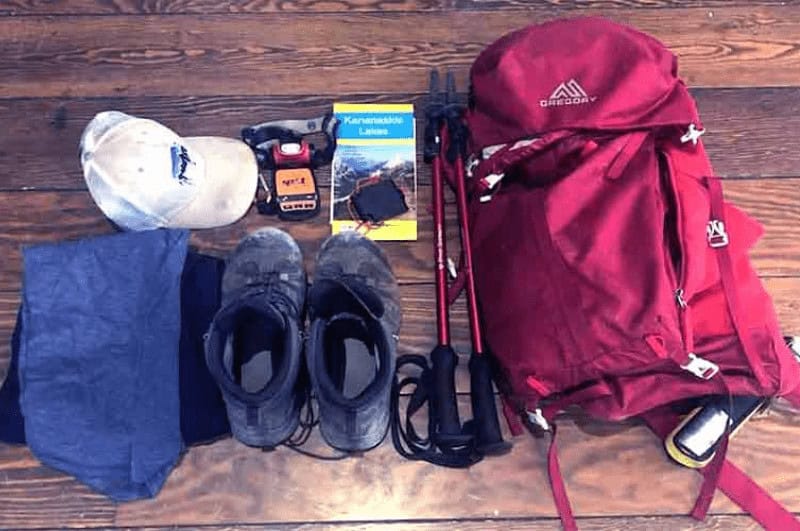
Necessary and suitable equipment and gear are necessary for smooth and successful trekking. Like insurance, the gear and equipment are to be purchased by the trekker and will not be included in the package offered by the travel agency.
Most trekkers rent their gear once they get to Nepal, and the agencies can recommend the necessary items and places to purchase them. For instance, some of the basic requirements are warm gloves, sleeping bags, raincoats, trekking shoes, water bottles, poles, boots, socks, and thermal clothing.
The overall cost for renting EBC trekking gear will range between $200 and $500, depending on the quality of equipment you prefer.
Trekking permits
If you want to trek to Everest Base Camp, you will need to purchase two permits. Possibly three:
- Sagarmatha National Park Entry Permit ($30)
- Khumbu Rural Municipality Entrance Permit ($20)
- Gaurishankar Conservation Area Permit ($30) – optional
Mount Everest lies within the protected area of Sagarmatha National Park, a UNESCO World Heritage Site. The Sagarmatha National Park Entry permit can be purchased in Monjo or Kathmandu..
The Khumbu Pasang Lhamu Gaupalika Permit can be purchased at either Monjo or Lukla. It has replaced the Trekker’s Information Management System (TIMS), so you no longer need to get a TIMS for Everest.
If you intend to trek all the way from Jiri or Salleri, then you will also need a Gaurishankar Conservation Area Permit. This permit can be obtained in Kathmandu at Nepal Tourism Board Office.
VAT (Value Added Tax)
The government of Nepal charges 18% VAT (value added tax) on all goods and services. Most travel companies in Nepal include this tax in the cost of the tour
Otherwise, you will need to pay those taxes yourself.
Transportation in Nepal
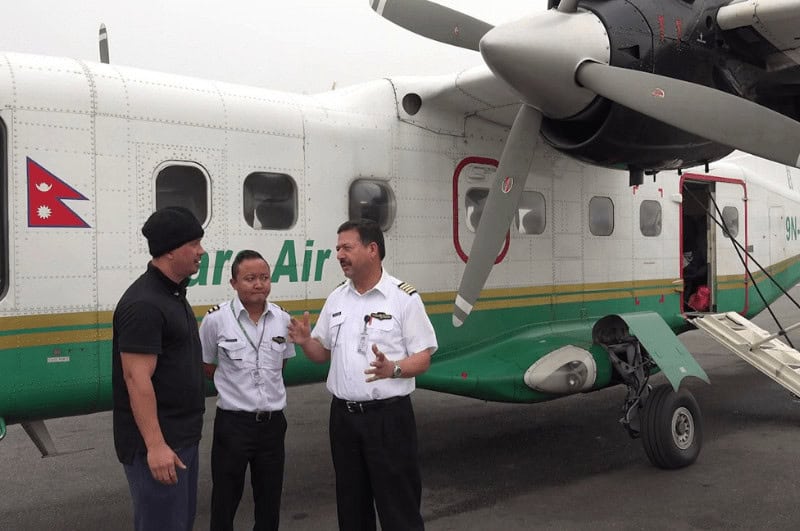
The highest cost of the trek is the cost of the flight to Lukla. A round-trip flight between Kathmandu and Lukla costs between $360 and $380 per person.
There's a limit of only 10 kilos of luggage per person on a domestic flight. You should bring only the necessary things on the trek and leave the rest behind in the hotel in Kathmandu.
Alternatively, you can take a jeep or bus from Kathmandu to Jiri ($17-$21) and then trek up to Lukla. This works well if you have extra days and are interested in the trek and experiencing the country some more. Be sure to factor in food and lodging on the way.
Food & water during the trek
Food is relatively expensive while trekking to Everest Base Camp since everything has to be brought in by porter or yak.
On the trek, budget $25-$35 per day for food. Bring extra money if you don't want to run out of cash.
A simple meal like dal bhat (lentils and rice) will cost anywhere from $4 to $7, depending on how far up the trail the teahouse is. You should also budget for snacks like chocolate bars, biscuits, and instant noodles, which can cost between $1 and $5.
Water is also not free on the trek. For a cup of warm boiled water, they may charge you between $0.50 and $3, depending on the location. Stick to drinking boiled or filtered water and bring plenty of purification tablets so you can stay hydrated.
Plastic bottles are banned in the region, so buy a reusable bottle that filters the water so you can drink from any source safely. Grayl and Lifestraw are popular brands on the trek.
TIP: Avoid eating meat during the journey. There's no telling how long it has been without refrigeration. The Sherpa do not kill animals, so any meat that you see has been flown from Kathmandu to Lukla, then carried up the trail by mules or porters.
Accommodation on the trek
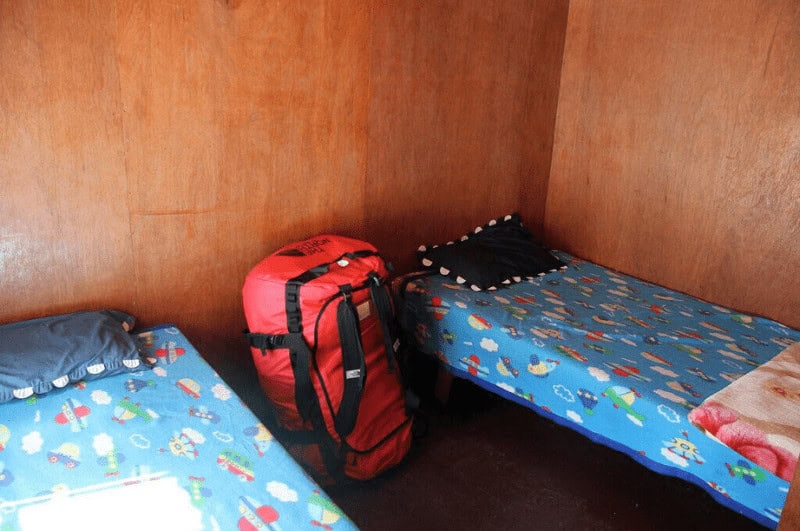
Having a great place to rest at the end of the day is a significant part of your trek. You will have options and choices of hotels on your way, which can range from low-end teahouses to moderate hotels and luxurious lodges.
You can expect to pay $3 per night/person at a simple teahouse, or around $5 per night for two beds. The more famous lodges cost more ($7 at Lobuche and $10 at Gorak Shep). It's expected that you will have breakfast and dinner at the teahouse you stay in.
Teahouses are an excellent approach to immerse yourself in the local lifestyle. There's a common room for dinner, heated by a wood-burning stove. This is where everyone comes to eat and unwind.
A typical room in a teahouse will have two beds, a pillow, and a blanket. Toilets are usually located outside of the main building, and squat toilets are very common.
tip: Bring a roll of toilet paper with you on the trek. You never know when or where you'll have to relieve yourself.
Hot showers are available for an extra $5 to $10. Similarly, you'll have to pay around $5 to charge your electronic gadget.
Cost of a trek guide and porter
Although some trekkers enjoy the challenge of doing it on their own, trekking to Base Camp Everest with a guide and a porter makes the journey far more enjoyable.
A guide's expertise and knowledge will enrich your trekking experience. You will be able to learn more about the trail and some history about trails, villages, and people living around it. Regardless of what you need help with – whether it's finding the best tea house or simply getting through the hike itself – he can assist you every step of the way.
A porter can ease your burden by carrying your heavy bags, leaving you with only a light backpack to carry. This means you will enjoy a pleasant trekking experience. This also means you help the local economy by offering jobs to the local people.
Guides and porters work on a day rate. A guide typically receives $30-$40, while a porter will run around $25-$30 per day. You can pay them at the end of the trek.
Tipping
Regarding tipping, trekkers happily tip their porter and guide as a way of showing their appreciation for good service. The rule of thumb is to tip 10-15% of the guide's and porter's total fee (about $5 per day for the guide and $3 per day for the porter). You can either tip in USD or Nepali Rupees.
Additional costs to consider
Extra costs include hot showers, internet, an electric blanket, charging electronic devices, and having food in different places besides the one you are staying at.
If you are not staying in an ensuite room, a hot shower will cost you between $2 and $10. Similarly, you'll have to pay between $2 and $6 to charge your electronic gadget and up to $10 to charge a power bank.
An electric blanket per night will cost you between $18 and 20. Internet access will cost between $2 and $5 per hour with moderate internet service.
Want to save this for later?
Save this pin on your favorite Pinterest travel board.
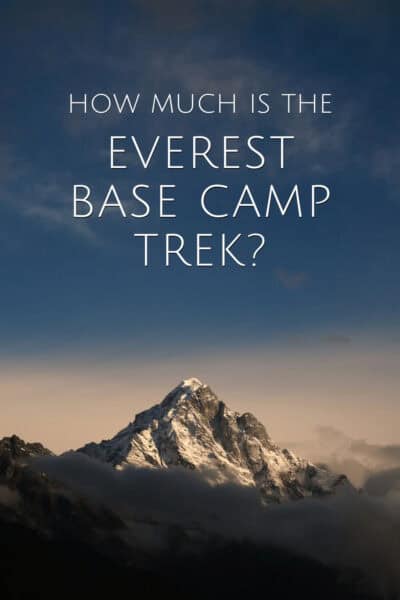
How to save money on the Everest Base Camp trek
The best way to save money on the trek is by doing your research and making informed decisions. Low-budget operators are not always the best choice. Some may have substandard guides, could exploit the porters (aka sherpas), might offer fewer services, and may not take appropriate safety measures. Do your due diligence beforehand.
Here are some tips:
- Do your research: Read blogs, talk to people who have done the Everest Base Camp trek before, and look at different tour companies to get an idea of ratings, what they offer, and what the trek entails. This will help you plan and budget for the trip.
- Go during the off-season: The most popular months for trekking in the Everest region are from late March to mid-May and from late September to November. Outside of these times, prices are lower and the crowds are thinner.
- If you have your own gear, bring it with you. This includes things like a sleeping bag, warm clothes, hiking boots, etc. If you don't intend to use it again, renting the gear is a smarter financial decision.
- You could also save money by cooking your own meals or camping along the way instead of staying in teahouses.
Final thoughts
The Everest Base Camp trek is a rewarding and challenging experience that is well worth the expense. By doing your research and booking ahead, you can save money on the trek while still enjoying all the highlights that this iconic journey has to offer.

